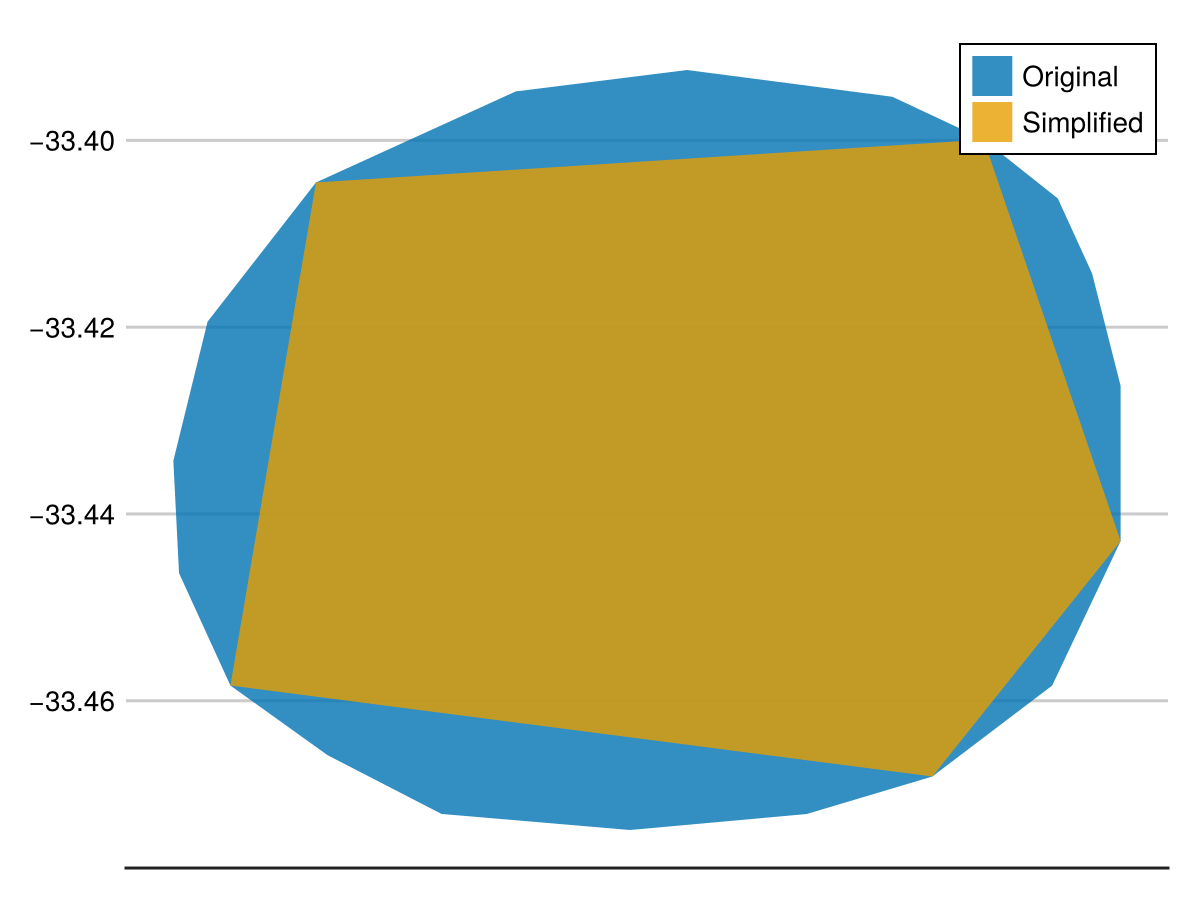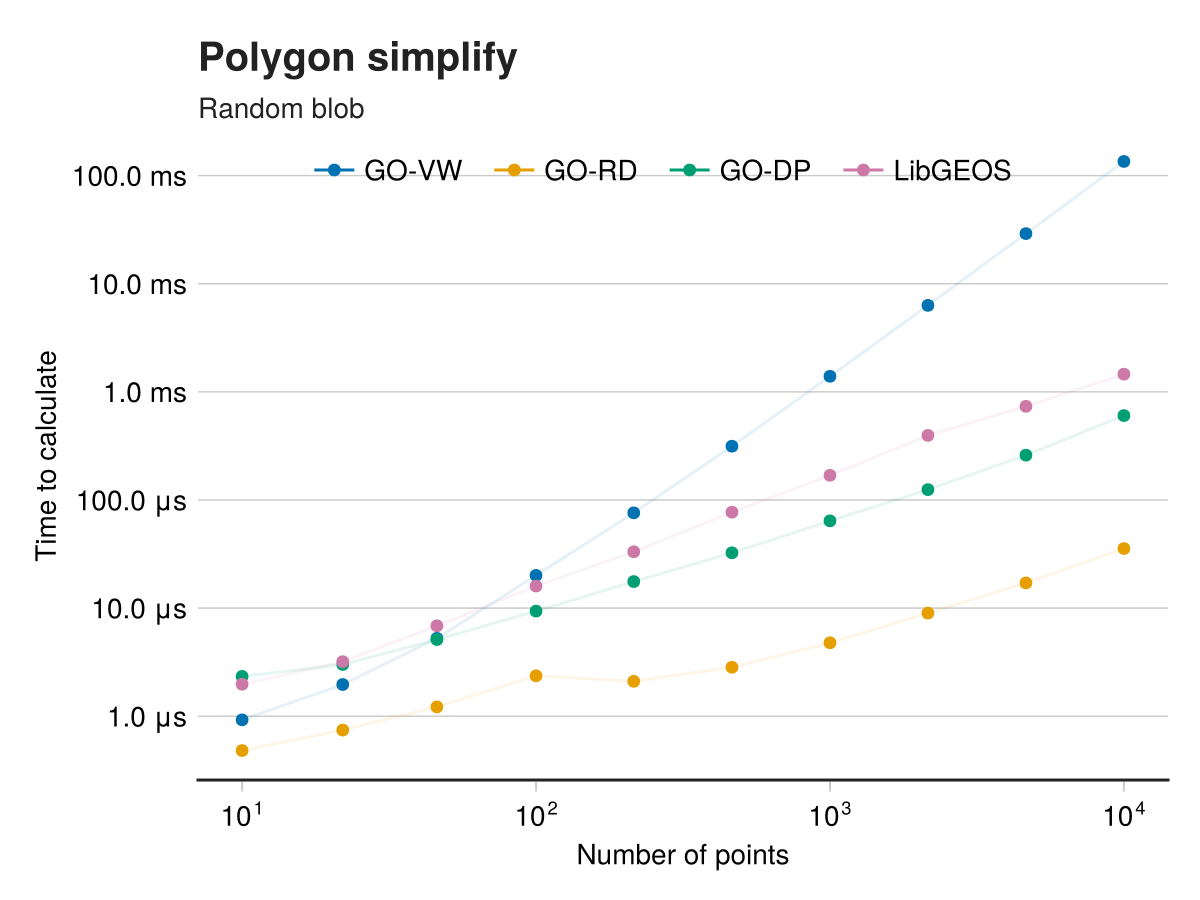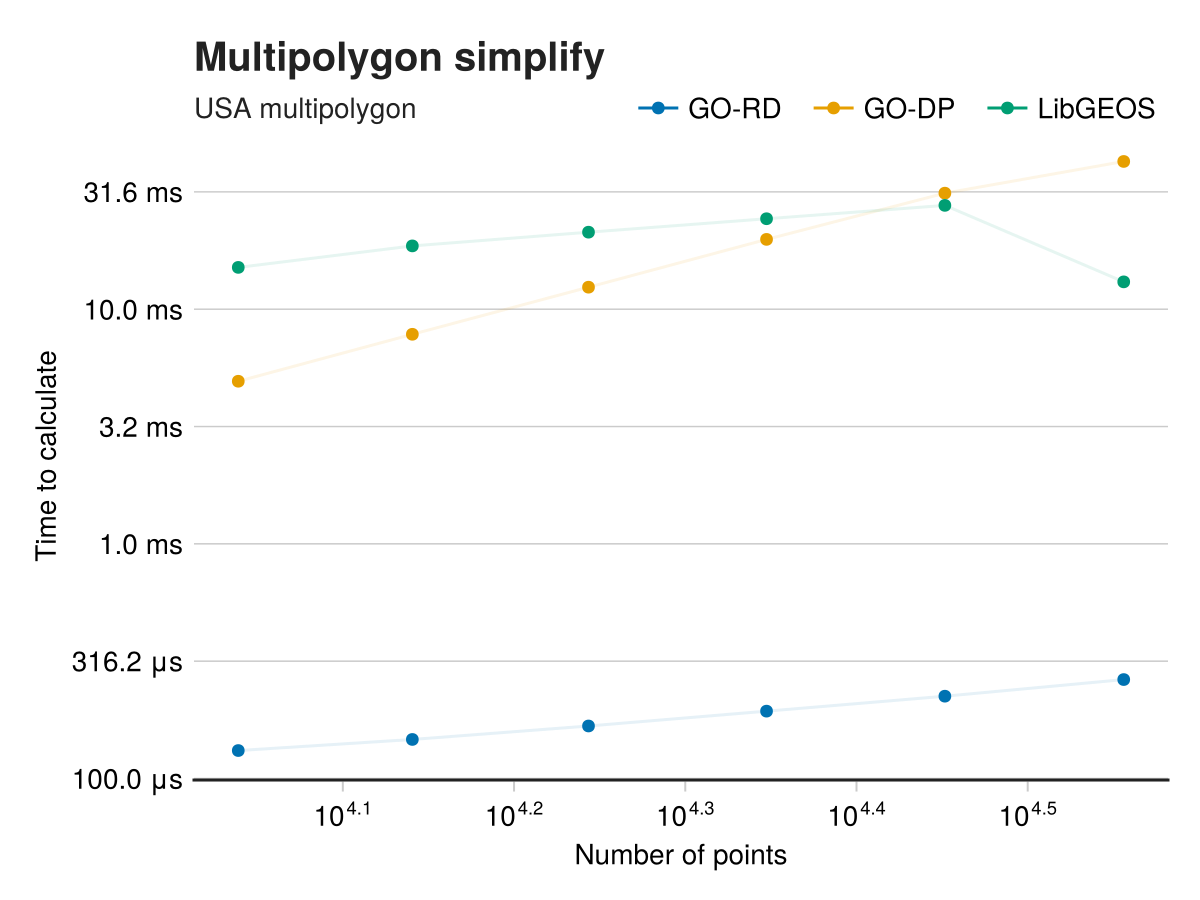Geometry simplification
This file holds implementations for the RadialDistance, Douglas-Peucker, and Visvalingam-Whyatt algorithms for simplifying geometries (specifically for polygons and lines).
The GEOS extension also allows for GEOS's topology preserving simplification as well as Douglas-Peucker simplification implemented in GEOS. Call this by passing GEOS(; method = :TopologyPreserve) or GEOS(; method = :DouglasPeucker) to the algorithm.
Examples
A quick and dirty example is:
using Makie, GeoInterfaceMakie
import GeoInterface as GI
import GeometryOps as GO
original = GI.Polygon([[[-70.603637, -33.399918], [-70.614624, -33.395332], [-70.639343, -33.392466], [-70.659942, -33.394759], [-70.683975, -33.404504], [-70.697021, -33.419406], [-70.701141, -33.434306], [-70.700454, -33.446339], [-70.694274, -33.458369], [-70.682601, -33.465816], [-70.668869, -33.472117], [-70.646209, -33.473835], [-70.624923, -33.472117], [-70.609817, -33.468107], [-70.595397, -33.458369], [-70.587158, -33.442901], [-70.587158, -33.426283], [-70.590591, -33.414248], [-70.594711, -33.406224], [-70.603637, -33.399918]]])
simple = GO.simplify(original; number=6)
f, a, p = poly(original; label = "Original")
poly!(simple; label = "Simplified")
axislegend(a)
f
Benchmark
We benchmark these methods against LibGEOS's simplify implementation, which uses the Douglas-Peucker algorithm.
using BenchmarkTools, Chairmarks, GeoJSON, CairoMakie
import GeometryOps as GO, LibGEOS as LG, GeoInterface as GI
using CoordinateTransformations
lg_and_go(geometry) = (GI.convert(LG, geometry), GO.tuples(geometry))
# Load in the Natural Earth admin GeoJSON, then extract the USA's geometry
fc = GeoJSON.read(read(download("https://rawcdn.githack.com/nvkelso/natural-earth-vector/ca96624a56bd078437bca8184e78163e5039ad19/geojson/ne_10m_admin_0_countries.geojson")))
usa_multipoly = fc.geometry[findfirst(==("United States of America"), fc.NAME)] |> x -> GI.convert(LG, x) |> LG.makeValid |> GO.tuples
include(joinpath(dirname(dirname(pathof(GO))), "test", "data", "polygon_generation.jl"))
usa_poly = GI.getgeom(usa_multipoly, findmax(GO.area.(GI.getgeom(usa_multipoly)))[2]) # isolate the poly with the most area
usa_centroid = GO.centroid(usa_poly)
usa_reflected = GO.transform(Translation(usa_centroid...) ∘ LinearMap(Makie.rotmatrix2d(π)) ∘ Translation((-).(usa_centroid)...), usa_poly)
f, a, p = plot(usa_poly; label = "Original", axis = (; aspect = DataAspect()))#; plot!(usa_reflected; label = "Reflected")
This is the complex polygon we'll be benchmarking.
simplify_suite = BenchmarkGroup(["Simplify"])
singlepoly_suite = BenchmarkGroup(["Polygon", "title:Polygon simplify", "subtitle:Random blob"])
include(joinpath(dirname(dirname(pathof(GO))), "test", "data", "polygon_generation.jl"))
for n_verts in round.(Int, exp10.(LinRange(log10(10), log10(10_000), 10)))
geom = GI.Wrappers.Polygon(generate_random_poly(0, 0, n_verts, 2, 0.2, 0.3))
geom_lg, geom_go = lg_and_go(LG.makeValid(GI.convert(LG, geom)))
singlepoly_suite["GO-DP"][GI.npoint(geom)] = @be GO.simplify($geom_go; tol = 0.1) seconds=1
singlepoly_suite["GO-VW"][GI.npoint(geom)] = @be GO.simplify($(GO.VisvalingamWhyatt(; tol = 0.1)), $geom_go) seconds=1
singlepoly_suite["GO-RD"][GI.npoint(geom)] = @be GO.simplify($(GO.RadialDistance(; tol = 0.1)), $geom_go) seconds=1
singlepoly_suite["LibGEOS"][GI.npoint(geom)] = @be LG.simplify($geom_lg, 0.1) seconds=1
end
plot_trials(singlepoly_suite; legend_position=(1, 1, TopRight()), legend_valign = -2, legend_halign = 1.2, legend_orientation = :horizontal)
multipoly_suite = BenchmarkGroup(["MultiPolygon", "title:Multipolygon simplify", "subtitle:USA multipolygon"])
for frac in exp10.(LinRange(log10(0.3), log10(1), 6)) # TODO: this example isn't the best. How can we get this better?
geom = GO.simplify(usa_multipoly; ratio = frac)
geom_lg, geom_go = lg_and_go(geom)
_tol = 0.001
multipoly_suite["GO-DP"][GI.npoint(geom)] = @be GO.simplify($geom_go; tol = $_tol) seconds=1
# multipoly_suite["GO-VW"][GI.npoint(geom)] = @be GO.simplify($(GO.VisvalingamWhyatt(; tol = $_tol)), $geom_go) seconds=1
multipoly_suite["GO-RD"][GI.npoint(geom)] = @be GO.simplify($(GO.RadialDistance(; tol = _tol)), $geom_go) seconds=1
multipoly_suite["LibGEOS"][GI.npoint(geom)] = @be LG.simplify($geom_lg, $_tol) seconds=1
println("""
For $(GI.npoint(geom)) points, the algorithms generated polygons with the following number of vertices:
GO-DP : $(GI.npoint( GO.simplify(geom_go; tol = _tol)))
GO-RD : $(GI.npoint( GO.simplify((GO.RadialDistance(; tol = _tol)), geom_go)))
LGeos : $(GI.npoint( LG.simplify(geom_lg, _tol)))
""")
# GO-VW : $(GI.npoint( GO.simplify((GO.VisvalingamWhyatt(; tol = _tol)), geom_go)))
println()
end
plot_trials(multipoly_suite)
export simplify, VisvalingamWhyatt, DouglasPeucker, RadialDistance
const _SIMPLIFY_TARGET = TraitTarget{Union{GI.PolygonTrait, GI.AbstractCurveTrait, GI.MultiPointTrait, GI.PointTrait}}()
const MIN_POINTS = 3
const SIMPLIFY_ALG_KEYWORDS = """
# Keywords
- `ratio`: the fraction of points that should remain after `simplify`.
Useful as it will generalise for large collections of objects.
- `number`: the number of points that should remain after `simplify`.
Less useful for large collections of mixed size objects.
"""
const DOUGLAS_PEUCKER_KEYWORDS = """
$SIMPLIFY_ALG_KEYWORDS
- `tol`: the minimum distance a point will be from the line
joining its neighboring points.
"""
"""
abstract type SimplifyAlg
Abstract type for simplification algorithms.
# API
For now, the algorithm must hold the `number`, `ratio` and `tol` properties.
Simplification algorithm types can hook into the interface by implementing
the `_simplify(trait, alg, geom)` methods for whichever traits are necessary.
"""
abstract type SimplifyAlg end
"""
simplify(obj; kw...)
simplify(::SimplifyAlg, obj; kw...)
Simplify a geometry, feature, feature collection,
or nested vectors or a table of these.
`RadialDistance`, `DouglasPeucker`, or
`VisvalingamWhyatt` algorithms are available,
listed in order of increasing quality but decreaseing performance.
`PoinTrait` and `MultiPointTrait` are returned unchanged.
The default behaviour is `simplify(DouglasPeucker(; kw...), obj)`.
Pass in other `SimplifyAlg` to use other algorithms.Keywords
- `prefilter_alg`: `SimplifyAlg` algorithm used to pre-filter object before
using primary filtering algorithm.
$APPLY_KEYWORDS
Keywords for DouglasPeucker are allowed when no algorithm is specified:
$DOUGLAS_PEUCKER_KEYWORDSExample
Simplify a polygon to have six points:
```jldoctest
import GeoInterface as GI
import GeometryOps as GO
poly = GI.Polygon([[
[-70.603637, -33.399918],
[-70.614624, -33.395332],
[-70.639343, -33.392466],
[-70.659942, -33.394759],
[-70.683975, -33.404504],
[-70.697021, -33.419406],
[-70.701141, -33.434306],
[-70.700454, -33.446339],
[-70.694274, -33.458369],
[-70.682601, -33.465816],
[-70.668869, -33.472117],
[-70.646209, -33.473835],
[-70.624923, -33.472117],
[-70.609817, -33.468107],
[-70.595397, -33.458369],
[-70.587158, -33.442901],
[-70.587158, -33.426283],
[-70.590591, -33.414248],
[-70.594711, -33.406224],
[-70.603637, -33.399918]]])
simple = GO.simplify(poly; number=6)
GI.npoint(simple)output
6
```
"""
simplify(alg::SimplifyAlg, data; kw...) = _simplify(alg, data; kw...)
simplify(alg::GEOS, data; kw...) = _simplify(alg, data; kw...)Default algorithm is DouglasPeucker
simplify(
data; prefilter_alg = nothing,
calc_extent=false, threaded=false, crs=nothing, kw...,
) = _simplify(DouglasPeucker(; kw...), data; prefilter_alg, calc_extent, threaded, crs)
#= For each algorithm, apply simplication to all curves, multipoints, and
points, reconstructing everything else around them. =#
function _simplify(alg::Union{SimplifyAlg, GEOS}, data; prefilter_alg=nothing, kw...)
simplifier(geom) = _simplify(GI.trait(geom), alg, geom; prefilter_alg)
return apply(simplifier, _SIMPLIFY_TARGET, data; kw...)
end
# For Point and MultiPoint traits we do nothing
_simplify(::GI.PointTrait, alg, geom; kw...) = geom
_simplify(::GI.MultiPointTrait, alg, geom; kw...) = geom
# For curves, rings, and polygon we simplify
function _simplify(
::GI.AbstractCurveTrait, alg, geom;
prefilter_alg, preserve_endpoint = true,
)
points = if isnothing(prefilter_alg)
tuple_points(geom)
else
_simplify(prefilter_alg, tuple_points(geom), preserve_endpoint)
end
return rebuild(geom, _simplify(alg, points, preserve_endpoint))
end
function _simplify(::GI.PolygonTrait, alg, geom; kw...)
# Force treating children as LinearRing
simplifier(g) = _simplify(
GI.LinearRingTrait(), alg, g;
kw..., preserve_endpoint = false,
)
lrs = map(simplifier, GI.getgeom(geom))
return rebuild(geom, lrs)
endSimplify with RadialDistance Algorithm
"""
RadialDistance <: SimplifyAlg
Simplifies geometries by removing points less than
`tol` distance from the line between its neighboring points.
$SIMPLIFY_ALG_KEYWORDS
- `tol`: the minimum distance between points.
Note: user input `tol` is squared to avoid uneccesary computation in algorithm.
"""
@kwdef struct RadialDistance <: SimplifyAlg
number::Union{Int64,Nothing} = nothing
ratio::Union{Float64,Nothing} = nothing
tol::Union{Float64,Nothing} = nothing
function RadialDistance(number, ratio, tol)
_checkargs(number, ratio, tol)square tolerance for reduced computation
tol = isnothing(tol) ? tol : tol^2
new(number, ratio, tol)
end
end
function _simplify(alg::RadialDistance, points::Vector, _)
previous = first(points)
distances = Array{Float64}(undef, length(points))
for i in eachindex(points)
point = points[i]
distances[i] = _squared_euclid_distance(Float64, point, previous)
previous = point
end
# Never remove the end points
distances[begin] = distances[end] = Inf
return _get_points(alg, points, distances)
endSimplify with DouglasPeucker Algorithm
"""
DouglasPeucker <: SimplifyAlg
DouglasPeucker(; number, ratio, tol)
Simplifies geometries by removing points below `tol`
distance from the line between its neighboring points.
$DOUGLAS_PEUCKER_KEYWORDS
Note: user input `tol` is squared to avoid uneccesary computation in algorithm.
"""
@kwdef struct DouglasPeucker <: SimplifyAlg
number::Union{Int64,Nothing} = nothing
ratio::Union{Float64,Nothing} = nothing
tol::Union{Float64,Nothing} = nothing
function DouglasPeucker(number, ratio, tol)
_checkargs(number, ratio, tol)square tolerance for reduced computation
tol = isnothing(tol) ? tol : tol^2
return new(number, ratio, tol)
end
end
#= Simplify using the DouglasPeucker algorithm - nice gif of process on wikipedia:
(https://en.wikipedia.org/wiki/Ramer-Douglas-Peucker_algorithm). =#
function _simplify(alg::DouglasPeucker, points::Vector, preserve_endpoint)
npoints = length(points)
npoints <= MIN_POINTS && return pointsDetermine stopping critetia
max_points = if !isnothing(alg.tol)
npoints
else
npts = !isnothing(alg.number) ? alg.number : max(3, round(Int, alg.ratio * npoints))
npts ≥ npoints && return points
npts
end
max_tol = !isnothing(alg.tol) ? alg.tol : zero(Float64)Set up queue
queue = Vector{Tuple{Int, Int, Int, Float64}}()
queue_idx, queue_dist = 0, zero(Float64)
len_queue = 0Set up results vector
results = Vector{Int}(undef, max_points + (preserve_endpoint ? 0 : 1))
results[1], results[2] = 1, npointsLoop through points until stopping criteria are fulfilled
i = 2 # already have first and last point added
start_idx, end_idx = 1, npoints
max_idx, max_dist = _find_max_squared_dist(points, start_idx, end_idx)
while i ≤ min(MIN_POINTS + 1, max_points) || (i < max_points && max_dist > max_tol)Add next point to results
i += 1
results[i] = max_idxDetermine which point to add next by checking left and right of point
left_idx, left_dist = _find_max_squared_dist(points, start_idx, max_idx)
right_idx, right_dist = _find_max_squared_dist(points, max_idx, end_idx)
left_vals = (start_idx, left_idx, max_idx, left_dist)
right_vals = (max_idx, right_idx, end_idx, right_dist)Add and remove values from queue
if queue_dist > left_dist && queue_dist > right_distValue in queue is next value to add to results
start_idx, max_idx, end_idx, max_dist = queue[queue_idx]Add left and/or right values to queue or delete used queue value
if left_dist > 0
queue[queue_idx] = left_vals
if right_dist > 0
push!(queue, right_vals)
len_queue += 1
end
elseif right_dist > 0
queue[queue_idx] = right_vals
else
deleteat!(queue, queue_idx)
len_queue -= 1
endDetermine new maximum queue value
queue_dist, queue_idx = !isempty(queue) ?
findmax(x -> x[4], queue) : (zero(Float64), 0)
elseif left_dist > right_dist # use left value as next value to add to results
push!(queue, right_vals) # add right value to queue
len_queue += 1
if right_dist > queue_dist
queue_dist = right_dist
queue_idx = len_queue
end
start_idx, max_idx, end_idx, max_dist = left_vals
else # use right value as next value to add to results
push!(queue, left_vals) # add left value to queue
len_queue += 1
if left_dist > queue_dist
queue_dist = left_dist
queue_idx = len_queue
end
start_idx, max_idx, end_idx, max_dist = right_vals
end
end
sorted_results = sort!(@view results[1:i])
if !preserve_endpoint && i > 3Check start/endpoint distance to other points to see if it meets criteria
pre_pt, post_pt = points[sorted_results[end - 1]], points[sorted_results[2]]
endpt_dist = _squared_distance_line(Float64, points[1], pre_pt, post_pt)
if !isnothing(alg.tol)Remove start point and replace with second point
if endpt_dist < max_tol
results[i] = results[2]
sorted_results = @view results[2:i]
end
elseRemove start point and add point with maximum distance still remaining
if endpt_dist < max_dist
insert!(results, searchsortedfirst(sorted_results, max_idx), max_idx)
results[i+1] = results[2]
sorted_results = @view results[2:i+1]
end
end
end
return points[sorted_results]
end
#= find maximum distance of any point between the start_idx and end_idx to the line formed
by conencting the points at start_idx and end_idx. Note that the first index of maximum
value will be used, which might cause differences in results from other algorithms.=#
function _find_max_squared_dist(points, start_idx, end_idx)
max_idx = start_idx
max_dist = zero(Float64)
for i in (start_idx + 1):(end_idx - 1)
d = _squared_distance_line(Float64, points[i], points[start_idx], points[end_idx])
if d > max_dist
max_dist = d
max_idx = i
end
end
return max_idx, max_dist
endSimplify with VisvalingamWhyatt Algorithm
"""
VisvalingamWhyatt <: SimplifyAlg
VisvalingamWhyatt(; kw...)
Simplifies geometries by removing points below `tol`
distance from the line between its neighboring points.
$SIMPLIFY_ALG_KEYWORDS
- `tol`: the minimum area of a triangle made with a point and
its neighboring points.
Note: user input `tol` is doubled to avoid uneccesary computation in algorithm.
"""
@kwdef struct VisvalingamWhyatt <: SimplifyAlg
number::Union{Int,Nothing} = nothing
ratio::Union{Float64,Nothing} = nothing
tol::Union{Float64,Nothing} = nothing
function VisvalingamWhyatt(number, ratio, tol)
_checkargs(number, ratio, tol)double tolerance for reduced computation
tol = isnothing(tol) ? tol : tol*2
return new(number, ratio, tol)
end
end
function _simplify(alg::VisvalingamWhyatt, points::Vector, _)
length(points) <= MIN_POINTS && return points
areas = _build_tolerances(_triangle_double_area, points)
return _get_points(alg, points, areas)
endCalculates double the area of a triangle given its vertices
_triangle_double_area(p1, p2, p3) =
abs(p1[1] * (p2[2] - p3[2]) + p2[1] * (p3[2] - p1[2]) + p3[1] * (p1[2] - p2[2]))Shared utils
function _build_tolerances(f, points)
nmax = length(points)
real_tolerances = _flat_tolerances(f, points)
tolerances = copy(real_tolerances)
i = [n for n in 1:nmax]
this_tolerance, min_vert = findmin(tolerances)
_remove!(tolerances, min_vert)
deleteat!(i, min_vert)
while this_tolerance < Inf
skip = false
if min_vert < length(i)
right_tolerance = f(
points[i[min_vert - 1]],
points[i[min_vert]],
points[i[min_vert + 1]],
)
if right_tolerance <= this_tolerance
right_tolerance = this_tolerance
skip = min_vert == 1
end
real_tolerances[i[min_vert]] = right_tolerance
tolerances[min_vert] = right_tolerance
end
if min_vert > 2
left_tolerance = f(
points[i[min_vert - 2]],
points[i[min_vert - 1]],
points[i[min_vert]],
)
if left_tolerance <= this_tolerance
left_tolerance = this_tolerance
skip = min_vert == 2
end
real_tolerances[i[min_vert - 1]] = left_tolerance
tolerances[min_vert - 1] = left_tolerance
end
if !skip
min_vert = argmin(tolerances)
end
deleteat!(i, min_vert)
this_tolerance = tolerances[min_vert]
_remove!(tolerances, min_vert)
end
return real_tolerances
end
function tuple_points(geom)
points = Array{Tuple{Float64,Float64}}(undef, GI.npoint(geom))
for (i, p) in enumerate(GI.getpoint(geom))
points[i] = (GI.x(p), GI.y(p))
end
return points
end
function _get_points(alg, points, tolerances)
# This assumes that `alg` has the properties
# `tol`, `number`, and `ratio` available...
tol = alg.tol
number = alg.number
ratio = alg.ratio
bit_indices = if !isnothing(tol)
_tol_indices(alg.tol::Float64, points, tolerances)
elseif !isnothing(number)
_number_indices(alg.number::Int64, points, tolerances)
else
_ratio_indices(alg.ratio::Float64, points, tolerances)
end
return points[bit_indices]
end
function _tol_indices(tol, points, tolerances)
tolerances .>= tol
end
function _number_indices(n, points, tolerances)
tol = partialsort(tolerances, length(points) - n + 1)
bit_indices = _tol_indices(tol, points, tolerances)
nselected = sum(bit_indices)
# If there are multiple values exactly at `tol` we will get
# the wrong output length. So we need to remove some.
while nselected > n
min_tol = Inf
min_i = 0
for i in eachindex(bit_indices)
bit_indices[i] || continue
if tolerances[i] < min_tol
min_tol = tolerances[i]
min_i = i
end
end
nselected -= 1
bit_indices[min_i] = false
end
return bit_indices
end
function _ratio_indices(r, points, tolerances)
n = max(3, round(Int, r * length(points)))
return _number_indices(n, points, tolerances)
end
function _flat_tolerances(f, points)::Vector{Float64}
result = Vector{Float64}(undef, length(points))
result[1] = result[end] = Inf
for i in 2:length(result) - 1
result[i] = f(points[i-1], points[i], points[i+1])
end
return result
end
function _remove!(s, i)
for j in i:lastindex(s)-1
s[j] = s[j+1]
end
endCheck SimplifyAlgs inputs to make sure they are valid for below algorithms
function _checkargs(number, ratio, tol)
count(isnothing, (number, ratio, tol)) == 2 ||
error("Must provide one of `number`, `ratio` or `tol` keywords")
if !isnothing(number)
if number < MIN_POINTS
error("`number` must be $MIN_POINTS or larger. Got $number")
end
elseif !isnothing(ratio)
if ratio <= 0 || ratio > 1
error("`ratio` must be 0 < ratio <= 1. Got $ratio")
end
else # !isnothing(tol)
if tol ≤ 0
error("`tol` must be a positive number. Got $tol")
end
end
return nothing
endThis page was generated using Literate.jl.